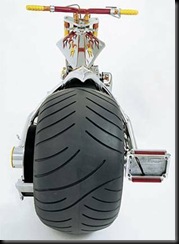Fat Bottomed Bikes
There seems to be a trend in custom bikes these days…. It is a disturbingly large rear tire.
Now, I like a beefy rear tire. Mated with a beefy tube frame, low profile, distinctive styling, I think that is a great look for a bike. But I have to ask the question; when is enough enough? Or rather, when is your rear tire wide enough?
I have now become more than awed by the new bike that I see sporting a 300 rear tire, I become downright opinionated.
Shooting major bike events has become a hobby, sport and job for me and I see a lot of bikes and meet a lot of bike builders. There are the builders that sit quietly near their show bikes ready to answer questions, accept compliments and search for buyers. And then there are the builders who see someone with a media pass and a camera and they seek me out to pull me over to their creations to actively show it off, hoping to get some press coverage on their bikes. More often than not, these builders have built a bike that has more than a wide rear tire… they have built a bike that has absolutely no need for a kickstand. I affectionately refer to these builders as “Fat Bottomed Boys”.
It is difficult for me at these events because I am there to take photos for whatever magazine has sent me, or in the hopes that I can sell a photo or story to a publication, and I am well aware of the fact that the media and the public seem to be drawn to these oversized monstrosities for the shock value. Over and over again, I read press releases announcing the newest, biggest, baddest tire… 250 turned to 280 and then 300 and now 330 and I’m sure there is a tire wider than that for sale somewhere.
When they ask me what I think of it, I think to myself that I am shooting it because it is outrageous, somewhat unique and has a chance to make a magazine. What I really think, and now have come to say out loud to the builder in most cases is that “I don’t care how fat your old lady is, you just don’t need that much rear fender.”
Ironically, the DOT has not approved a tire wider than 280 for street use. Now here arises the age-old argument of form following function; if it can’t be ridden on the street, is it really a motorcycle?
This summer I was at Krome Fest at Kelly’s bleachers and a “theme bike” was rolled out in front of the stage because it was a bike built for a raffle. The builder was selling tickets for a chance to win this bike. Prominently displayed on the informational sign was the statement that “This bike is not street legal”. Not this really shouldn’t disturb me as I know lots of bikes that I love that are missing amber forward lights, turn signals, horns, etc. and I love the fact that it is overlooked, but this bike had a tire on it that approached a ridiculous level and one that I don’t think most riders would be qualified to ride anyway.
I was once at an event where a man came right out and told me that he had a bike with such a wide rear tire that he found it almost impossible to maneuver nimbly under any circumstances and he hated riding it. When I pointed out that the trend was still strong for these wide rear tires, and now might be the time to sell it, he looked at me with a surprised expression and said, “well, I don’t like to ride it, but I don’t want to sell it!”
The bike building industry is a constant race to see who can come up with the next new thing, the “stand out” item to set a bike apart from the rest. I agree that the wide tire was one of those trends, but simply continuing to widen the rear tire is now becoming a cop out for real engineering and design.
Everything in moderation. J Lo has a great ass. J Lo has a big ass. But if J Lo had a great, big ass she wouldn’t be nearly as attractive. Let’s try to apply this sensibility to our bikes.
And that is how I see it, from behind the lens.
Colleen Swartz























